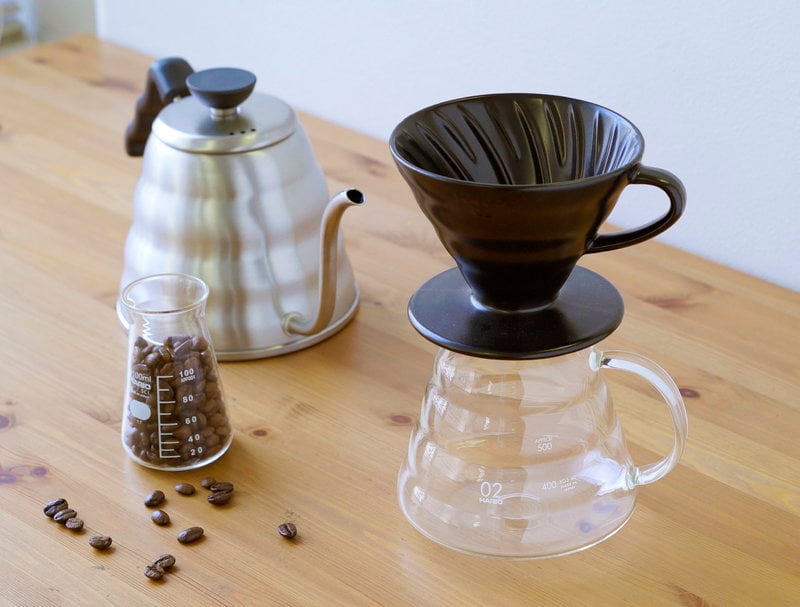How to Make a Good Pour Over Coffee | Beginner - Experts Guide
Manual brewers have become commonplace all over the coffee world, so where do you start if you want to get brewing on your own? In this article we cover brewing tips and as many pour over brewers as we can..
Manual brewers are found in a lot of peoples homes these days and the explosion in popularity has brought a whole heap of new an exciting manual brewers to the market, each with their own styles of brewing. Pour over dripper's especially have grown in popularity, becoming the easiest brewers to find and also becoming increasingly diverse with different shapes, sizes, filter materials, and usage recommendations.
So then, where do you start if you want to get brewing on your own? Well that is why we are writing this article...In this article we’ll cover general brewing tips and as many pour over brewers as we can.

Brewing Tips & Tricks
With a few guidelines, a couple of gadgets, and a willingness to experiment to learn what you love, you can become a master brewer in no time. These recommendations should get you headed in the right direction with almost any brewer you choose, but remember that the fastest way to learn will be to brew, taste, adjust, and record results while you’re getting a handle on your new gear.
A note: it’s most efficient to adjust one variable at a time as you’re updating your recipe. The relationships between the variables below gets complex and wildly unpredictable even for professionals if you adjust too many details too quickly. Take your time and make it easy on yourself—a little patience will go a long way.
The Gear: You don't need to get every pour over piece of equipment you can acquire in order make great pour over coffee. You just need the fundamentals to be great, that is you need a good burr grinder (or ground coffee), a good kettle, a good gram scaler & a good filter/dripper.
The Grind: Grind consistency and uniformity is the single most important variable in brewing consistently quality coffee. Luckily, it’s also one of the easiest coffee problems to solve with the right equipment. Once you have a good burr grinder it will be easier to experiment with what works for you, but the general guideline to bear in mind is that the finer the grind the shorter the contact time that brew should require (and vice-versa).
So a medium-coarse grinds will require a longer brew time then a medium fine grind. An ideal grind size will also be dependent on batch size for many brewers, so your small pour over filter will need a finer grind than your larger filter.
This is a good variable to experiment with as you’re dialing in your process—if your coffee is coming out consistently thin, weak, or sour, try a finer grind setting; if your coffee is coming out consistently bitter, harsh, or brothy, try a coarser grind setting.
The Ratio: Your coffee brew ratio will be the basis of your recipe. Many professionals say 60g of coffee per every 1 liter of water used, or to rephrase those numbers, approximately 1g of coffee per every 16.7g of water. Any brew ratio from 1:15 to 1:17 will fall within specialty coffee standards, but adjusting this ratio will have drastic effects on other variables in your brew, so I recommend finding one you like and sticking with it until you feel confident about the other variables you control.
The Water: Good quality water will keep your gear in good shape, and it will help your coffee shine to its fullest potential. You won’t need in-line filtration at home (unless, of course, you’re into that idea), but mixing up your own high quality water is getting easier and easier all the time.
The Temperature: If you try hard enough you can brew coffee with any temperature water you like, and it can be difficult to nail down a singularly agreed upon “best temperature” for brewing. The SCA says that the ideal temperature range for brewing coffee is 195°F–205°F (90.5°C–96°C) when water contacts ground coffee. What we can say for sure is that stability is important no matter which brew temperature you choose, so preheating your brewer thoroughly to make sure that you don’t lose too much heat too quickly will be very important for your consistency as a brewer.
The Brewers
2X Espresso's Pour Over Filter/Dripper
Style & Design:
The 2X Espresso Filter is designed with everyday life and the environment in mind oh and of course great coffee too. The filter doesn't require you to use any paper filters and is very durable, meaning you can take it where ever you go without worrying it will brake. We have added universal wings to the filter to ensure that it will fit on pretty much any cup or mug you use. The filter can make 1-3 cups of coffee and comes in one universal size.


Grind:
We suggest a medium grind for a 20-40 gram dose. We like our coffee strong so when we use the filter we typically use 30-50 grams of coffee to produce a cup of pour over.
Technique:
Start by unfolding the wings of the filter and placing it over your cup. Strat boiling your water and whilst the water is boiling measure out your coffee grounds. Once you have the perfect amount with a spoon put the ground coffee in the filter. Once the water is boiled pour about 30-40 mls over the coffee and let it bloom, wait about a minute for the gases to release and continue pour in concentric circles. Done, easy as that.
To clean the filter simply water for the coffee grounds to dry in the filter then tap them out into your compost or bin. Next wash the remaining residue under the tap and you'll be good to go.
V60
Style & Design:
A classic now in modern coffee, the V60 is the standard for a cone-shaped pour over dripper. Notably, its spiraled ridges inside of the brewer promote even extraction through the entire bed of coffee, and its availability in 5 different material options (glass, ceramic, plastic, copper, and steel) and 3 different sizes (01, 02 and 03, intended for approximately 350ml, 600ml, and 1L brews respectively)

Grind
A medium-fine grind is typically best for a brew around 400ml. Plan to adjust finer or coarser depending on your batch and brewer size.
Technique
Start by placing your filter into the brewer and rinsing your filter thoroughly with hot water. Add your coffee, start your timer, and pour 10-15% of your total brew water evenly over the grounds. After 30 seconds have elapsed on your timer begin adding the rest of your water to the brewer; keep a slow and even pour, moving in concentric circles from the center outward (up to ~¼” from the edge of the brewer). Continue until you’ve added water to your desired brew ratio and let all of the water finish flowing through the brewer. Total brew time should be around 3 minutes for a brew around 400ml; expect faster brew times around 2 minutes for smaller brews, and brew times getting as long as 5–6 minutes for 1L brews in your 03 size V60.
Chemex
Style & Design
Arguably the most classic piece of brewing equipment still available today, the Chemex marries science and design with its unibody borosilicate glass brew cone and decanter, Chemex-Bonded® filter paper, and museum-worthy styling. Available in 3, 6, 8, and 10 cup sizes, detailed with either a sleek glass handle or a light colored wooden collar the Chemex does well at giving you enough variety without getting in the way of the simplicity that has sustained the brewer for three-quarters of a century.

Grind
Medium to medium-coarse is recommended for most brews. Plan to adjust according to batch size, following that a 400ml brew will need to be a bit finer than a 1L brew.
Technique
Insert your Chemex filter into the brewing cone with three layers of filter paper against the side of the brewer with the spout, rinse thoroughly with hot water and dispose of the rinse water. Add your coffee, start your timer, and pour 10-15% of your total brew water evenly over the grounds. After 30 seconds have elapsed on your timer begin adding the rest of your water to the brewer in stages; keep a slow and even pour and ensure that you don’t pour water directly down the sides of the filter. Continue pouring water in pulses until reaching your target brew ratio; allow all of the brew water finish flowing through the coffee bed before discarding your filter. Total brew time should be 4–5 minutes for most brews in your 6, 8, or 10 cup Chemex.
We want to hear from you! Which pour-over brewers do you love? What techniques and parameters are you using? Are there any brewers that you’d love to see on our list? Comment below and let’s talk about it—we’re always so excited to learn something new from you!
What Double Shot Espresso is about
Who are we? We are at our core travel, coffee and creative enthusiasts. We have combined these three passions to bring you 2X Espresso which will help you find the best products and places to explore.


0 comments